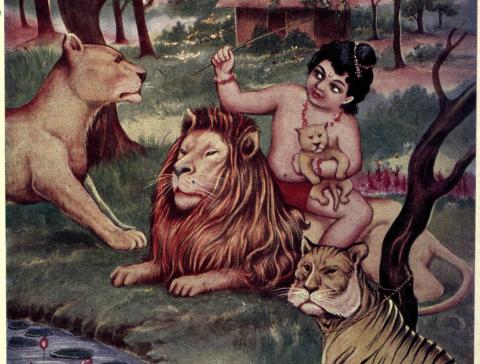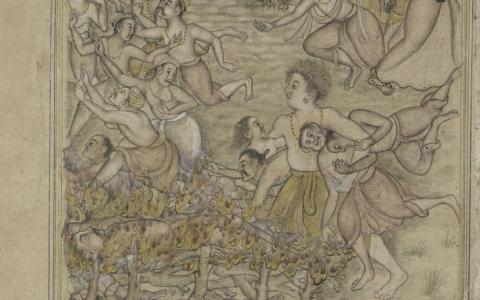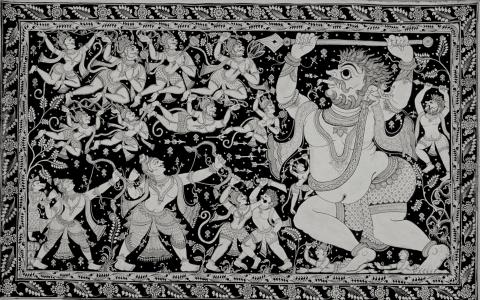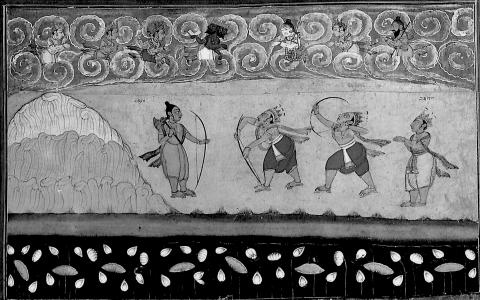March 2020

Naiṣadhīya-carita is considered the touchstone of scholarly poetry. Śrī-harṣa (12th cen. CE), its author, takes delight in proclaiming that he composed this work to ward off lesser mortals:
ग्रन्थग्रन्थिरिह क्वचित्क्वचिदपि न्यासि प्रयत्नान्मया
प्राज्ञम्मन्यमना हठेन पठिती मास्मिन् खलः खेलतु।
श्रद्धाराद्धगुरुश्लथीकृतदृढग्रन्थिः समास्वादय-
त्वेतत्काव्यरसोर्मिमज्जनसुखव्यासज्जनं सज्जनः॥[1]
I have wilfully made many parts of this work knotty—no...

অর্জুনকে শোক থেকে বিরত থাকার জন্য অনুরোধ করে কৃষ্ণ গীতার সূচনা করেন – “জীবিত বা মৃত, কারোর জন্য অশ্রুপাত করনা” (ভ. গী. ২.১১)। এবং তিনি গীতার পরিসমাপ্তিও করেন অর্জুনকে শোক থেকে বিরত থাকার জন্য অনুরোধ ক’রে – “আমার উপর বিশ্বাস রাখ। আমি তোমাকে মোক্ষ প্রদান করব। তুমি কেঁদো না” (ভ. গী. ১৮.৬৬)। ক্রন্দন থেকে বিরত থাকার এই দুটি মন্ত্রণার মাঝেই তিনি গীতার সমস্ত শিক্ষাদান করেন। কিন্তু কৃষ্ণ তাঁর নিজের জীবনে কি কখনও অশ্রুপাত করেছেন ? মহাভারতের সমস্ত মহান যো...

Duṣyanta – “Listening to the story you just narrated confirms that you indeed are a princess from a royal lineage. Please be my wife! Tell me what you desire to have! Golden necklaces, clothing, earrings, bangles, gems and gold coins – I will give them all. My entire kingdom will be yours. Please be my wife. Let us get married through gāndharva-vivāha. It is the best among the various kinds of marriages.”
Śakuntalā – “O King! My father is gone...

Footprints of Scholarly Temerity
In the progress from Kālidāsa to Bāṇa-bhaṭṭa, Sanskrit literature saw a decisive shift in terms of mind-set: what emanated as the seasoned self-confidence of poets transformed into loud self-assertion. While this took the dimension of learned entertainment (vidyā-vinoda) among poets, it assumed the form of rigorous debates (vāda-vaibhava) among scholars. This is the period in which Sanskrit poetry became the...

ಆ ರಥದ ಸ್ವರೂಪದ ವಿವರಣೆಯನ್ನು ಓದಿದ ಮೇಲೆ ರಥ ಎಂದರೆ ಹೇಗಿರಬಹುದೆಂಬ ಬೃಹತ್ ಕಲ್ಪನೆ ನಮ್ಮ ಮುಂದೆ ಸುಳಿಯುತ್ತದೆ.
ಅರಸ ಕೇಳೈಹತ್ತು ಸಾವಿರ-
ತುರಗನಿಕರದ ಲಳಿಯ ದಿವ್ಯಾಂ-
ಬರದ ಸಿಂಧದ ಸಾಲ ಸತ್ತಿಗೆಗಳ ಪತಾಕೆಗಳ |
ಖರರುಚಿಯ ಮಾರಾಂಕವೋ ಸುರ-
ಗಿರಿಯ ಸೋದರವೋ ಮೃಗಾಂಕನ
ಮರುದಲೆಯೊ ಮೇಣೆನಲು ರಥ ಹೊಳೆದುದಂಬರದಿ || (ಅರಣ್ಯ ಪರ್ವ 7.12)
ಇಂತಹ ದಿವ್ಯರಥವನ್ನು ಏರಿದ ಅರ್ಜುನನನ್ನು ಮಾತಲಿ “ಧೃಢವಾಗು” ಎಂದು ಹೇಳಿ ಕುದುರೆಗಳನ್ನು ಚಪ್ಪರಿಸುತ್ತಾನಂತೆ – ವಿಮಾನ ಮೇಲೇರುವಾಗ ಬೆಲ್ಟ್ಗಳನ್ನು ಕಟ್ಟಿಕೊಳ್ಳಿ ಎನ್ನುವಂತೆ – ರಥ ಮೇಲೇರುತ್ತಿದ್ದಂತೆ ಅರ...

Kāvyavācana[1]
Thanks to such readings and recitations, people from our neighbourhood used to come and gather at our place. Attikunte Sripatiraya, Lingapura Narasappa, Koppara Varadayya, Kandācāra Rukmniniyamma and others. He is used to correct me if I made any mistakes while reading. Once, it was some episode from Mahābhārata. There was a gathering consisting of a group of saints. It was worded in the book as “Kaśyapa, Jābāli and other...

கல்வி மற்றும் நடத்தைக்கான விதிமுறை[1]
வேதம் கற்பதன் குறிக்கோள் மந்திரங்களை மனப்பாடம் செய்வது மாத்திரம் அல்ல. பாடத்தின் பொருளையும் மாணவர்கள் அறிந்திருக்க வேண்டும். பண்டைய அறிஞர்கள் பலர் குருட்டு மனப்பாடத்தை கண்டனம் செய்தும், பொருளுணர்ந்து (தியானித்து) பயில்வதைப் போற்றியும் உள்ளனர். இவ்வாறிருப்பினும், பல நூற்றாண்டுகளாக வேதம் பயின்றவர்கள் பொருளறியாமல் அவற்றை மனனம் மாத்திரமே செய்து வந்தனர். இது இன்றும் தொடர்கிறது.
பிரம்மசாரியின் நடத்தைக்கான கோட்பாடு...

There lived a king named Duṣyanta who belonged to the lineage of Puru. He was valorous and was ruling over the earth in a dhārmic manner. There was no varṇa-saṅkara, i.e., mixing of the varṇas in his kingdom. There were no hardships faced for cultivation of crops and for growing food. All citizens got their share of artha and kāma by strict adherence to dharma. No one committed sins. People knew no fear of thieves; they did not even know what...


